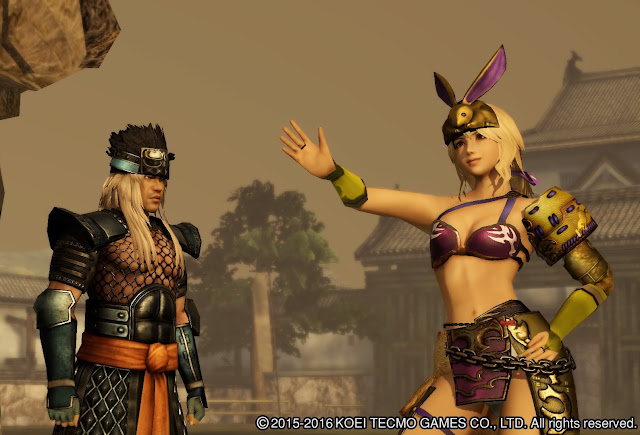Review by Matt S.
On the one hand, you have Samurai Warriors 4, which, as we all know, is an action-heavy take on Japan’s historic Sengoku period, a time in which many warlords clashed over ownership of Japan in some of the most famous battles of that country’s history. On the other hand is Nobunaga’s Ambition, which is a deeply strategic take on the same era. In Nobunaga’s Ambition players carefully develop their territories and armies before setting out on wars of conquest in carefully paced battles.
Related reading: You can check out Matt’s review of the Samurai Warriors 4 “base game” here.
And now there’s Samurai Warriors 4 Empires, which tries to find the middle ground between the two franchises. The Empires sub-series has always been Koei Tecmo’s most niche among its popular historical “simulations,” but it’s certainly a worthy franchise in its own right, and this latest edition is a good attempt at doing something a little different in the process.
At core the game remains a familiar blend between action and strategy that anyone who has played one of the previous Empires game will slip into comfortably. It’s broken up into two parts – there’s a turn-based layer where time is measured season to season, and players can select from a wide range of different actions, from developing the towns in the region (to provide more coin and food), to winning new generals to the side, training new troops, or improving relationships between the leaders so they fight more effectively on the battlefield.
Never take on Dee Dee on the battlefield 😛 https://t.co/vhVxpo8IP2 pic.twitter.com/prabZlUq5t— Digitally Downloaded (@DigitallyDownld) March 14, 2016
This is the part where Empires finds its greatest innovations this time around. Rather than present the players with a dry and generally unnecessarily complex menu system, as we have seen in some games from the series in the past, this time around Koei Tecmo has opted to represent the information through a rendering of the player’s home castle. It looks a little like a doll’s house or diorama, opened in the middle, so you can see each of the rooms within, and the people currently in the building. Each of the rooms represent a key administrative role, such as military or town development. Into those rooms players can appoint generals to they key administrative roles, where they will offer advice on the next best course of action.
You can ignore those suggestions if you’d like, of course, and forge your nation according to your own strategies, but the advice the administrators provide is typically sound, so for people that want to simply kick back and play, this system represents a far more accessible and streamlined way of moving through the strategic side of the game. You could call it “easy”, until you realise that to succeed on the higher difficulty levels, you are going to need to carefully consider what strategic options you take on; even if you are relying on the administrator’s advice, there are always more options for what you can do than you have capacity to do in any given month.
The other side to the coin is the combat. Where Nobunaga’s Ambition gives you control of entire armies, in Samurai Warriors 4 Empires you’re looking at vintage Warriors stuff; you’ll be in command of a single character, and you’ll be mowing through enemies hordes by the hundreds. The goal in each battle is to capture key points spread around the battlefield, on the way to target the enemy’s stronghold. You could in theory beeline straight to the stronghold, but until you’ve captured the satellite command posts, enemies within the stronghold will be overwhelmingly powered up. You’ll also need to frequently backtrack to grapple with enemy leaders that are targeting your captured territories in order to win them back.
There’s a good flow to the battles in Samurai Warriors 4 Empires, with the frantic need to move around the battlefield enough to keep you active without being overwhelming in pulling you in too many different directions at once. The strategies you come up with in the nation building help by providing you with stronger allies and conditions to fight within. While there’s a lot you’re able to achieve yourself (and as with most Warriors games, ultimately victory in a battle does rest on your own sword, with allies generally unable to take down an enemy general by themselves), you still need to be careful about going all-in with too many invasions of opposition territory; spread your forces too thinly, and a neighbour will take the opportunity to invade your own territories and roll through the weakened forces.
Related reading: An interview with the producer of Samurai Warriors 4 Empires.
I really liked how scenarios are structured, too. Though there’s no real narrative to speak of (and that’s a pity because the Sengoku period has some wonderful stories to tell of individual heroism, and it is indeed one of the real pulls behind the main Samurai Warriors series), in each scenario you’re tasked with a goal that the real-world warlord had. For example, Motochika Chōsokabe’s goal is not to capture all of Japan, but rather take control of just Shikoku island – a region of four states. Other warlords have loftier ambitions, however in most cases it’s possible to achieve the goal in just a couple of hours of play. At that point you can claim victory and the scenario ends, or you can play on to try and capture all of Japan. This is a great approach, as it means the more time limited of us can play a larger number of scenarios without having to commit to a single campaign that might take weeks, if not months, to complete.
The other key feature in this game is the ability to create your own generals and stick them in whatever role you might like in your nation. The character creation is as comprehensive as normal for Koei Tecmo, and it’s possible to have the character (Dee Dee, in my case) form relationships with the other heroes and become a powerful general in their (her) own right. Because none of the characters have a particularly strong personality in this game, created characters fit in far better than in other Warriors games, and they help you to take real ownership over what’s going on in the game in the process.
The Warriors games do look good on the PlayStation 4, and Samurai Warriors 4 Empires is no different, especially with the lovely Japanese architecture and nature that’s on display. There’s nothing quite like fighting under cherry blossom trees. However, having come off the wide open, epic battlefields of Arslan, it’s a little dampening to find that most of the action in Samurai Warriors 4 Empires flows through corridors bordered by impassable terrain. It’s not something you’ll necessarily notice while playing, but away from the game the funnels built into the level design become something frustrating on reflection. Battlefields are at their most exciting when they take place across wide plains, and if there’s one thing I’d like to see the next generation of both Dynasty and Samurai Warriors games address it’s that the combat areas are becoming increasingly cramped.
Ultimately the success of Samurai Warriors 4 Empires rests on how well it has been able to merge action and strategy together, and while I feel this veers strongly on the side of action, compared with even the Dynasty Warriors Empires series, there’s still enough thinky stuff to do between battles to add nuance to the overall experience. For that, Samurai Warriors 4 Empires has become my preferred Samurai Warriors game, though I would strongly recommend people play one of the previous Samurai Warriors games to get a proper feel for the characters and setting before digging into the more abstract and cerebral experience on offer here.
As to the main question of whether this title manages to sit in the middle, between a Warriors title and Nobunaga’s Ambition, I’ve got to say that it does. Purists will prefer the titles on either end of this particular spectrum, but I am sure there is an audience out there for a game that offers a balance of strategy and action and subtly weaves them together to reward people that take the time to master both.
– Matt S.
Editor-in-Chief
Find me on Twitter: @digitallydownld










